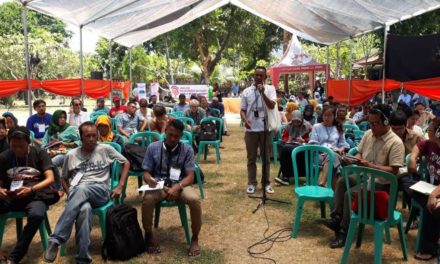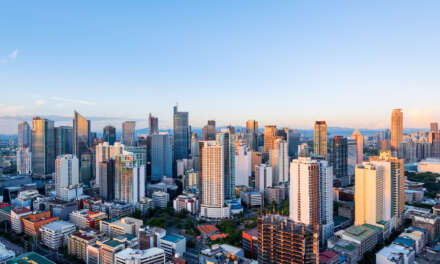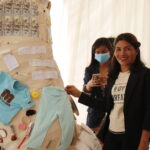WTO Director General Roberto Azevedo has openly declared that the “negotiating agenda” for the Bali Conference can extend beyond that of the Doha Round. On October 7, he told reporters in New Delhi: “Bali is in my view absolutely critical in establishing the conditions for moving forward in areas other than the deliverables we are looking for in December, not only in the Doha development agenda but also in other issues which are trade-related and also of interest to member-countries.”[i]
The U.S. on the other hand has hinted on a post-Bali agenda that will include the launch of new negotiations using new approaches. In a recent speech, USTR Froman said “Bali has the potential to be a vital step towards the WTO creating something new, something that can lead to other new opportunities—to innovation in our approach to multilateral negotiations.”[ii]
It is becoming clear that the outcome envisioned in Bali will be an agreement on the so-called Bali package and a Bali Declaration that will map out the road ahead for the WTO and the free trade agenda beyond Bali.
What are the elements of this post-Bali package that is being alluded to and why should people be wary of this emerging agenda?
New (and not so new) issues
Bali can introduce more issues in the WTO agenda. For the longest time the introduction of new issues, also known as Singapore issues (trade facilitation, competition policy, government procurement and investments), to the agenda has been resisted by developing countries. In Bali, a possible multilateral agreement on trade facilitation can pave the way not just for the other new issues to be included in the agenda but facilitate the negotiations on other issues such as:
Environmental Goods and Services – The Doha Agenda provided the mandate for negotiations on trade in environmental goods and services. The negotiations on EGS which deal broadly with the reduction or elimination of tariff and non-tariff barriers to environmental goods and services are taking place in two separate bodies in the WTO. The environmental goods part is being discussed under the Non-Agricultural Market Access (NAMA) talks while the services part is being handled by the Special Session of the Council for Trade in Services (CTS-SS).
The OECD defines EGS as an industry “that consists of activities which produce goods and services to measure, prevent, limit, minimize or correct environmental damage to water, air and soil, as well as problems related to waste, noise and eco-systems. This includes cleaner technologies, products, and services that reduce environmental risk and minimize pollution and resource use.”[iii]
This agenda received a big boost in 2010 when the leaders of the Asia Pacific Economic Cooperation (APEC) issued a Declaration that contained the following statement on environmental goods and services:
“We will increase the dissemination and utilization of environmental goods and services, reduce existing barriers and refrain from introducing new barriers to trade and investment in such goods and services, and enhance our capabilities to develop this sector, by prioritizing work related to addressing non-tariff measures on environmental goods, technology, and services.”[iv]
APEC leaders subsequently firmed up their commitment and “resolved to reduce by the end of 2015 our applied tariff rates (on a list of environmental goods) to 5 percent or less, taking into account economies’ circumstances, without prejudice to APEC economies’ positions in the WTO. Economies will also eliminate non-tariff barriers, including local content requirements that distort environmental goods and services trade.”[v] The list of around 54 environmental goods to be liberalized by 2015 came out as Annex C of the 2012 APEC leaders Declaration.[vi]
This agenda on liberalization of trade and investment in environmental goods and services is being pushed under the broad mantle of the green economy, in the name of addressing climate change and in pursuit of so called sustainable development goals.
But here is the catch. Because developed countries have by and large already liberalized their market for EGS, the renewed calls for liberalization mean that the developing countries are the ones that have to make the greater commitment. This would entail not just cutting or eliminating altogether tariffs on EGS, binding greater number of products and services, elimination of non-tariff barriers, but also reform of regulatory policies on services that promote domestic over foreign interests, which are deemed barriers to trade.
The proposals to liberalize EGS have thus been criticized by emerging countries like Brazil and India as “market access” proposals meant to push the export of products (not all necessarily environmental or climate-related goods) to developing country markets.[vii]
The push for EGS is indicative of a broader agenda anchored still on a competitiveness driven, export-oriented development model under the so called ‘green economy’.
Global value chains – Another buzz phrase that is being pushed in the WTO agenda is the concept of global value chains. According to a joint report from the Organization for Economic Cooperation and Development (OECD), WTO and UNCTAD that came out recently, “global value chains have become a dominant feature of world trade and investment, offering new prospects for growth, development, and jobs.”[viii]
The GVC perspective presents a new way of looking at globalization through the lens of global production of goods and services which has become geographically fragmented over the years. According to a joint WTO and Japan’s Institute of Developing Economies (IDE-Jetro) report on GVC in East Asia, the emergence of GVC or otherwise referred to as “production sharing, vertical specialization, trade in tasks, or supply chain trade” represents a “fundamental change in the structure of world trade.”[ix]
The emphasis is not just that global production is now spread across countries but that each country that participates in the chain makes a contribution in adding value to production whether through their export of raw materials, assembly, or design, etc. As the WTO report on East Asia asserts nowadays, products are more “made in the world” than “made in a specific country.”[x] The WTO has been promoting this idea through its ‘Made in the World’ initiative which is meant to “support the exchange of projects, experiences, and practical approaches in measuring and analysing trade in value added.”[xi] Here is the pitch: Countries that are part of a common production chain should work towards easing trade restrictions, ensuring investment in technology dissemination, skills building and upgrading to ensure that all who participate can reap the benefits from trade.
New approaches
In the guise of “new and innovative approaches” to negotiations and in the name of overcoming the stalemate in the Doha talks[xii], there has been a renewed push for plurilateral agreements in the WTO.
Since 2012, upon the initiative of the United States and Australia, talks have proceeded towards a Trade in Services Agreement (TiSA), a stand-alone plurilateral agreement on services being negotiated by around 50 countries collectively known as “really good friends of services” group (RGFS)[xiii] that aim to liberalize trade and investment in services and expand regulatory disciplines on all services sectors including public services.
According to Public Services International (PSI) “the disciplines, or treaty rules, would provide all foreign providers access to domestic markets at “no less favorable” conditions as domestic suppliers and would restrict governments’ ability to regulate, purchase, and provide services. This would essentially change the regulation of many public and privatized or commercial services from serving the public interest to serving the profit interests of private, foreign corporations.”[xiv]
PSI outlined the core elements of TiSA: (1) liberalization in essentially all modes and sectors adopting a negative list approach as opposed to the positive list approach under the General Agreement on Trade in Services (GATS) where Members are given the leeway to specify which sectors will be covered by commitments to liberalize; (2) national treatment for foreign service providers; (3) there will be a process to multilateralize the agreement by allowing other countries to sign-on to the agreement; (4) strong enforceability mechanism which is mostly likely to include a provision on investor to state dispute settlement mechanism; (5) ‘standstill clause’ against new “restrictive” regulations and a ‘ratchet clause’ that automatically binds autonomous elimination of regulatory measure in the future.
While the TiSA is clearly a plurilateral agreement, there are questions whether this should remain outside or should it become in the near future a multilateral agreement under the WTO. A serious concern at the moment is the absence of emerging economies Brazil, China, India and the ASEAN countries in the talks. The European Commission (EC) for example thinks it “not desirable that all those countries (that are not currently part of the TiSA talks) would reap the benefits of the possible future agreement without in turn having to contribute to it and to be bound by its rules.” The EC is therefore pushing that “the automatic multilateralization of the agreement based on the MFN principle should be temporarily pushed back as long as there is no critical mass of WTO members joining the agreement.”[xv]
Higher standards
A new element in multilateral trade negotiations has been the launch of so called new generation FTAs (see section on Second Front: New Generation FTAs) which are highly ambitious and comprehensive trade and investment agreements like the TPP, the TTIP, and the EU FTAs in Canada, Korea, Singapore, among others. These ambitious economic agreements are pushing the boundaries of commitments to trade and investment liberalization beyond those agreed under the WTO or even in older preferential trade agreements. WTO plus standards are apparent in the areas of intellectual property rights (IPR) and investments which will be a threat to people’s rights and welfare and can lead to serious erosion of space for crafting policy that will support broader development goals and objectives.
[i] Speech delivered by Director General Roberto Azevedo before Federation of Indian Chambers of Commerce and Industry in New Delhi. Accessed at http://www.wto.org/english/news_e/spra_e/spra3_e.htm. Last visited 23 October 2013.
[ii] Keynote Speech delivered by USTR Michael Froman at WTO Public Forum on Innovation and the Global Trading System held in Geneva. 1 October 2013. Last viewed 18 October 2013.http://www.ustr.gov/about-us/press-office/speeches/transcripts/2013/september/froman-wto-innovation-global-trade
[iii] Opening Markets for Environmental Goods and Services. OECD Policy Brief. January 2005. http://www.oecd.org/tad/envtrade/35415839.pdf
[iv] 2010 APEC Leaders Declaration in Yokohama, Japan. 2010. http://www.apec.org/Meeting-Papers/Leaders-Declarations/2010/2010_aelm.aspx. Last accessed 29 October 2013.
[v]2011 APEC Leaders Declaration in Honolulu, Hawai. http://www.apec.org/Meeting-Papers/Leaders-Declarations/2011/2011_aelm.aspx. Last accessed 29 October 2013.
[vi] Annex C: APEC List of Environmental Goods. http://www.apec.org/Meeting-Papers/Leaders-Declarations/2012/2012_aelm/2012_aelm_annexC.aspx
[vii] TWN Info Service on WTO and Trade Issues (June10/04) 18 June 2010
Third World Network http://www.twnside.org.sg/title2/wto.info/2010/twninfo100604.htm
[viii] Implications Of Global Value Chains For Trade, Investments, Development And Jobs. OECD, WTO, UNCTAD. August 2013. http://www.oecd.org/trade/G20-Global-Value-Chains-2013.pdf
[ix] Trade patterns and global value chains in East Asia.: From trade in goods to trade in tasks. WTO and IDE-JETRO. http://www.wto.org/english/res_e/booksp_e/stat_tradepat_globvalchains_e.pdf
[x] Trade patterns and global value chains in East Asia.: From trade in goods to trade in tasks. WTO and IDE-JETRO. http://www.wto.org/english/res_e/booksp_e/stat_tradepat_globvalchains_e.pdf
[xii] Briefing paper prepared by the European Commission on TiSA. http://trade.ec.europa.eu/doclib/docs/2013/june/tradoc_151374.pdf
[xiii]RGFS group includes Australia, Canada, Chile, Chinese Taipei (Taiwan), Colombia, Costa Rica, European Union (28), Hong Kong, Iceland, Israel, Japan, Liechtenstein, Mexico, New Zealand, Norway, Pakistan, Panama, Paraguay, Peru, Republic of Korea, Switzerland, Turkey, and the United States.
[xiv] Public Services International (PSI) Briefing Paper on TiSA. July 2013. http://www.world-psi.org/sites/default/files/documents/research/en_psi_tisa_policy_brief_july_2013_final_web.pdf
[xv] Briefing paper prepared by European Commission on TiSA. http://trade.ec.europa.eu/doclib/docs/2013/june/tradoc_151374.pdf








